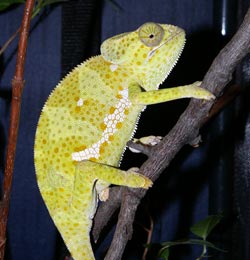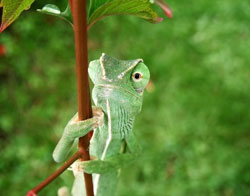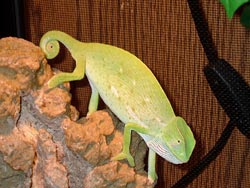Follow along with the video below to see how to install our site as a web app on your home screen.
Note: This feature may not be available in some browsers.
You should upgrade or use an alternative browser.
Flapneck, Graceful & Senegal Chameleons

Scientific Name: Chamaeleo dilepis
Common Names: Flapneck Chameleon
Scientific Name: Chamaeleo gracilis
Common Names: Graceful Chameleon
Scientific Name: Chamaeleo senegalensis
Common Names: Senegal Chameleon
Difficulty: Intermediate - These species are for more experienced keepers. They have additional husbandry requirements that can be difficult for people unfamiliar with general chameleon care.
Brief Introduction:
Due to similarities in care, Senegal, Graceful and Flapneck chameleons will all be described in this caresheet. These species are native to most of the equatorial countries of Africa and seem to prefer dry forest and savanna type habitats. All three chameleons species are almost exclusively available in the pet trade as wild caught specimens, which means they were born in their native wild habitat. Wild caught chameleons are very difficult pets to care for properly and require special care to acclimate to captivity. The chameleons that survive the wild collection and distribution process are severely stressed, dehydrated, and dealing with a heavy parasite load by the time they become available at a pet store or reptile show. Wild caught chameleons are not recommended for new keepers.
Description:
These chameleons come from a wide area of Africa and have large, stable wild populations. They are fairly plain in appearance and apart from ear flaps they have little other ornamentation like horns or rostral projections.
Ch. dilepis The flapneck chameleon is a medium sized species measuring 8-12" (20-30cm). The head is flat with a low casque and large occipital lobes (ear flaps). Their skin is smooth with a prominent white stripe across the flanks. Their colour is primarily green but dirty yellow and pale brown are also seen. Males are differentiated by their thicker tail base (hemipenal bulge) and some sub-species have a tarsal spur.
Ch. gracilis The graceful chameleon is a medium to large sized species measuring about 16" (40cm). The head is flat with a low casque and very small occipital lobes (ear flaps). They have slightly rougher looking, green coloured skin with a prominent white stripe across the flanks. Males have a thicker tail base (hemipenal bulge) and a tarsal spur.
Ch. senegalensis The senegal chameleon is a medium sized species measuring 10" (25cm) in total length. The head is plain and flat with no ear flaps or other adornments. The skin is smooth and both genders are primarily a uniform green. Males can be differentiated by their thicker tail base (hemipenal bulge).
Behavior:
Like most chameleon species these three chameleons are tree-dwelling reptiles that are active only during the day. They can generally be found hunting prey or basking on the branches of trees and large bushes. Chameleons are very territorial and don’t tolerate the presence of other chameleons in close proximity. When threatened they will frequently change color and inflate their body to appear larger. Contrary to popular belief, chameleons don’t change color in a direct attempt to match their background. Their color changes are influenced most by their state of health, emotions or level of stress, and the process of thermoregulation. While these species are relatively calm in comparison to others they are better for observation and should not be handled regularly.
Lifespan:
With proper husbandry these chameleons can live 3-5 years on average.
Male flapneck, graceful and Senegal chameleons are distinguished by a more prominent hemipenal bulge. The females tend to be larger than the males in all three species.

Temperature:
Adult: 70-80F (21-26C) ambient, 80-90F (26-32C) basking
Ambient temperature refers to the temperature near the bottom of the cage and basking temperature refers to the hottest point accessible to your chameleon. Basking is where a chameleon absorbs heat from an external overhead source to help regulate their body temperature; it also promotes proper digestion and a healthy metabolism. Nighttime temperatures can safely drop down to 50F (10C) so a night heat source should not be used unless temperatures are lower than this. If night heat is needed a ceramic heat emitter or space heater should be used, not a light bulb, even red or black bulbs.
Humidity:
Humidity is an important aspect of chameleon husbandry. These chameleon species require levels around 50-70%, which can be achieved by several misting sessions a day over all areas of the cage. Live plants help increase and maintain humidity. Sometimes a cool mist humidifier or timer-controlled misting system is needed. See Water & Humidity for more information.
Cage Size:
In general when housing chameleons, bigger is better. Chameleons are highly territorial and easily stressed by the presence of other chameleons, even of their own species. Two or more chameleons should never be kept in the same cage. Cages should be furnished with many plants and climbing branches to provide opportunities for exercise and plenty of places for hiding. Substrate (mulch, soil, etc.) should not be used in chameleon cages. See Chameleon Enclosures for more information.
screen cage (length x width x height):
16x16x30" (40x40x76cm) - Juveniles
18x18x36" (45x45x90cm) - Adult minimum
Lighting:
All lighting and heat bulbs should be outside and on top of the cage. There should be 12 hours of UVB light, along with 12 hours of darkness for proper rest. A UVB bulb is necessary to synthesize vitamin D3 in the skin and to facilitate absorption of dietary calcium. UVB bulbs only emit UVB rays for 6-8 months, even if they’re still shining, so they must be replaced at least twice a year. A basking bulb creates the heat gradient so that your cold-blooded chameleon can regulate its body temperature by moving into warmer or cooler zones as needed. When choosing a basking bulb start with a 60watt bulb and monitor temperature closely. Higher wattage bulbs are hotter in temperature and vice versa so choose the appropriate wattage bulb based on the temperatures achieved. A bulb that makes it too hot can burn your chameleon badly even from several inches away and through the screen. See Chameleon Lighting for more information.

Feeding:
Chameleons are insectivores meaning they should only be fed live insects. Great feeder insects include crickets, silkworms, hornworms, butterworms, dubia roaches and superworms. Waxworms and mealworms are high in fat content and harder to digest so should only be used on occasion. The rule of thumb is to not feed insects that are longer than the width of your chameleon's head.
Neonates: as many small crickets as they can eat several times a day
Juveniles 3-6 months of age: 10-12 small crickets daily
Juveniles 6-12 months of age: 10-12 medium crickets every other day
Adults over 12 months of age: 5-7 small-medium crickets every other day
Chameleons should be fed in the first half of the day to give them time to bask and digest their food properly. Crickets need to be properly gutloaded with calcium rich vegetables several hours before being fed to your chameleon. Inadequate dietary calcium leads to metabolic bone disease, a very serious illness. Commercially available gutloads usually aren't properly balanced or sufficient for good nutrition. See Chameleon Food for more information.
Supplementation:
Calcium and other vitamins are very important to your chameleon's health. Feeder insects should be lightly dusted with powdered supplement before being fed to your chameleon. Many keepers successfully use calcium (without D3 or phosphorus) at nearly every feeding, multivitamin once every 2 weeks, and calcium with D3 once every 2 weeks.
Hydration & Misting
The cage should be misted at least twice a day, drying out completely between misting sessions. This raises relative humidity as well as stimulates your chameleon to want to drink. Water can be provided by means of a dripper (not a waterfall or water bowl). The dripper should be placed on top of the cage so that the water droplets drip down and accumulate on plant leaves. Other watering options include manual and automated misting sytems. Chameleons do not recognize standing water as a drinking source. See Water & Humidity for more information.
Egg Laying & Breeding
Chameleons do not need to mate or even see a male to develop eggs. Like chickens they will lay infertile clutches of eggs periodically. Even if you only have a single female chameleon since she was a baby it will be critical to provide her a place to lay eggs because egg binding (being unable to lay eggs) is fatal. Chameleons can start to develop eggs as early as 4-6 months of age. However, it is highly recommended not to breed your chameleon until the female is at least a year of age so she is mature and can dedicate calcium stores to eggs instead of stripping it from her own growing bones. A receptive female will display bright yellow to signal the males. A clutch can contain on average 20-70 eggs and fertile or infertile makes no difference on size of clutch or whether or not the female will have trouble laying them. Females can lay 1-3 clutches per year on average, during any season. A single breeding may produce several clutches from the same pairing due to sperm retention by the female. Egg laying is a big strain on the female's body and heavy breeding can shorten life span. Extra calcium should be given to gravid females to keep up with the need of making eggshells. A female that is unable to lay her eggs for environmental, nutritional or medical reasons causes a serious condition of egg-binding, or being eggbound. This is a medical emergency and will be fatal if not treated. Over feeding can cause cause complications with egg laying and larger clutch sizes, making them more prone to becoming eggbound.
A female over 6 months of age should always have a laying bin available. The laying bin should be at least 16x16x16" with depth of substrate of at least 12" being crucial. The egg laying substrate should be either washed playsand or a mixture of washed playsand and organic soil moistened so that a tunnel retains its shape and does not collapse. There should be one or several branches going into the laying bin so that the female can crawl in and out as desired. A female about to lay eggs will often become restless, pace her cage and make decrease or stop eating in the week before. Once a female enters the laying bin she may dig several test holes before choosing to lay eggs. They dig head first to make the tunnel and then back into the tunnel to lay their eggs before covering the tunnel completely. It is absolutely critical to give a chameleon complete privacy while she is in the laying bin. If she is disturbed she may abandon her tunnel and could be become eggbound. The cage may need to be wrapped with a sheet with only a peep hole to keep disruptions out of sight. It can take several hours up to several days to lay eggs. A female that is weak, very uncomfortable, or refuses to use a laying bin may need veterinary assistance immediately. After a female lays eggs is it is very important to give her at least a week of minimal stress, increased hydration and calcium-rich food to recuperate.
Egg Incubation
The fertile eggs should be removed from where they were laid while maintaining the exact position they were laid in (do not turn). Keep the eggs half buried in incubation substrate inside a tupperware container with no holes, or only a few very small holes, in the lid. Eggs are incubated in coarse vermiculite or hatchrite moistened to the point that only there are only a few drops of water when a handful of the substrate is squeezed. Seal the lid completely to retain moisture or the eggs will dry out and not survive. Depending on the temperatures of your home veiled eggs can be placed in a dark cabinet for incubation rather than using an actual incubator. The eggs from these three species take an average 7-12 months to hatch when kept at optimal temperatures of 72-80F.
- Resource Link - How To Set Up A Laying Bin, by JannB
- Resource Link - Setting Up A Laying Bin Video, by Dez
- Resource Link The Senegal Chameleon, by Kristina Frances
- Resource Link The Chamaeleo Dilepis Complex, by Steven Deckers
Nečas, Petr. Chameleons: Nature's Hidden Jewels. Frankfurt Am Main: Edition Chimaira, 1999. Print.



